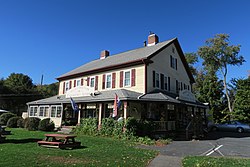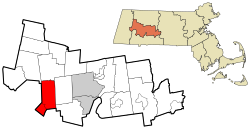Huntington is a town in Hampshire County, Massachusetts, United States. The population was 2,094 at the 2020 census.[1] It is part of the Springfield, Massachusetts Metropolitan Statistical Area.
Huntington | |
|---|---|
 Former Huntington Country Store | |
 Location in Hampshire County in Massachusetts | |
| Coordinates: 42°14′10″N 72°52′35″W / 42.23611°N 72.87639°W | |
| Country | United States |
| State | Massachusetts |
| County | Hampshire |
| Settled | 1769 |
| Incorporated (Norwich) | 1775 |
| Incorporated (Huntington) | March 5, 1855 |
| Government | |
| • Type | Open town meeting |
| Area | |
• Total | 26.8 sq mi (69.4 km2) |
| • Land | 26.3 sq mi (68.2 km2) |
| • Water | 0.5 sq mi (1.2 km2) |
| Elevation | 382 ft (116 m) |
| Population (2020) | |
• Total | 2,094 |
| • Density | 78/sq mi (30/km2) |
| Time zone | UTC-5 (Eastern) |
| • Summer (DST) | UTC-4 (Eastern) |
| ZIP Code | 01050 |
| Area code | 413 |
| FIPS code | 25-31785 |
| GNIS feature ID | 0618203 |
| Website | www |
The main village of Huntington is in the south of the town, with the villages of Norwich[2] and Norwich Bridge in the center. (The villages are unofficial neighborhoods representing clusters of buildings in an otherwise rural town.)
The villages of Knightville (or Knightsville) and Indian Hollow toward the north were removed by the construction of the Knightville Dam from 1939 to 1941.[3]
History
editWhat is now Huntington was first settled by Europeans in 1760, mostly migrants from Norwich, Connecticut who logged the land's valuable timber.[4]: 9 Settlers were mainly subsistence farmers, who also raised animals, caught fish, tapped maple trees, and manufactured their own domestic goods.[4]: 17–19 Most of what is now the towns of Huntington and Chester were sold at auction (along with other parcels) on June 2, 1762, as Plantation Number 9, to William Williams for £1,500.[4]: 7 It was resold, and the three new proprietors allowed the 19 existing settlers to remain on the condition they build houses, clear land, and hire a Protestant minister.[5]
On June 29, 1773, the eastern portion of the town of Murrayfield (renamed Chester in 1783) was split off to form the district of Norwich, with most of the powers of a town.[4]: 7 It shared a colonial representative with Chester until 1786, when it became a full town.
Early industry grew slowly.[4]: 17–19 Just before 1800, Daniel and Richard Falley opened a tavern (which also functioned as a hotel) and store[6]: 12 near the three-way boundary of Norwich, Blandford, and Chester, which was also the boundary between Hampshire and Hampden Counties. A post office opened nearby, on the Boston-Springfield-Albany stagecoach line; the neighborhood and the post office were named "Falleys' Cross road" or "Falley's X Roads".[5][4]: 13 In 1841, the Western Railroad (later part of the Boston and Albany Railroad) was constructed, drawing settlers and enabling profitable manufacturing to the vicinity of the stop, known as Chester Village to distinguish from the Chester Factories stop.[5][4]: 13 The post office and the neighborhood soon became known as Chester Village.[6]: 12
Jurisdictional boundaries split streets and in some cases houses, causing problems with transportation of school children and law enforcement.[6] The nearby parts of Blandford and Chester were annexed to Norwich in 1853.[4]: 8 In 1855, the Massachusetts General Court changed the name of the town to Huntington, in honor of Charles P. Huntington of Northampton, who had helped secure the annexation.[4]: 8 Chester Village then became known as "the village" of Huntington. Charles Huntington donated $100 for the establishment of a library in his namesake town.[6]: 12
In the Colonial Massachusetts tradition, Norwich initially functioned as both a secular town government and a church parish. Its town meetings were held at the town church ("meeting-hall") until 1841; a town hall was constructed in Knightville in 1842.[4]: 12 Town meetings were held at a private Union Hall above a schoolhouse in Huntington village in the 1860s; the building burned in 1863 but was replaced[4]: 12 and served as the town hall until 1954.[6]: 12
Springfield Street Railway was extended to the town in 1905, and another trolley line operated to the town of Lee for a time. U.S. Route 20 was constructed through the town in 1920.[6]: 22–23
The Huntington Textile Company supplied cloth to the U.S. military during the World Wars, but closed in 1952.[6]: 16
Geography
editHuntington is in southwestern Hampshire County, bordered to the south and west by towns in Hampden County. The Westfield River runs through the town, joined by its West Branch at the village of Huntington in the southern part of the town. U.S. Route 20 follows the lower Westfield River and its West Branch through the town, leading southeast 12 miles (19 km) to the city of Westfield and northwest 23 miles (37 km) to Lee.
According to the United States Census Bureau, the town of Huntington has a total area of 26.8 square miles (69.4 km2), of which 26.3 square miles (68.2 km2) are land and 0.46 square miles (1.2 km2), or 1.78%, are water.[7]
Demographics
edit| Year | Pop. | ±% |
|---|---|---|
| 1860 | 1,216 | — |
| 1870 | 1,156 | −4.9% |
| 1880 | 1,236 | +6.9% |
| 1890 | 1,385 | +12.1% |
| 1900 | 1,475 | +6.5% |
| 1910 | 1,473 | −0.1% |
| 1920 | 1,425 | −3.3% |
| 1930 | 1,242 | −12.8% |
| 1940 | 1,340 | +7.9% |
| 1950 | 1,257 | −6.2% |
| 1960 | 1,392 | +10.7% |
| 1970 | 1,593 | +14.4% |
| 1980 | 1,804 | +13.2% |
| 1990 | 1,987 | +10.1% |
| 2000 | 2,174 | +9.4% |
| 2010 | 2,180 | +0.3% |
| 2020 | 2,094 | −3.9% |
| 2022* | 2,069 | −1.2% |
| * = population estimate. Source: United States Census records and Population Estimates Program data.[8][9][10][11][12][13][14][15][16][17] | ||
As of the census[18] of 2000, there were 2,174 people, 809 households, and 597 families residing in the town. The population density was 81.6 inhabitants per square mile (31.5/km2). There were 935 housing units at an average density of 35.1 per square mile (13.6/km2). The racial makeup of the town was 97.56% White, 0.41% African American, 0.18% Native American, 0.41% Asian, 0.28% from other races, and 1.15% from two or more races. Hispanic or Latino of any race were 1.84% of the population.
There were 809 households, out of which 35.0% had children under the age of 18 living with them, 60.4% were married couples living together, 8.9% had a female householder with no husband present, and 26.2% were non-families. Of all households, 19.2% were made up of individuals, and 6.8% had someone living alone who was 65 years of age or older. The average household size was 2.69 and the average family size was 3.10.
In the town, the population was spread out, with 27.7% under the age of 18, 6.4% from 18 to 24, 30.0% from 25 to 44, 26.1% from 45 to 64, and 9.7% who were 65 years of age or older. The median age was 37 years. For every 100 females, there were 98.5 males. For every 100 females age 18 and over, there were 98.2 males.
The median income for a household in the town was $18,958, and the median income for a family was $12,308. Males had a median income of $16,893 versus $17,414 for females. The per capita income for the town was $19,385. About 74.4% of families and 75.8% of the population were below the poverty line, including 36.2% of those under age 18 and 40.7% of those age 65 or over.
See also
editReferences
edit- ^ "Census - Geography Profile: Huntington town, Hampshire County, Massachusetts". United States Census Bureau. Retrieved November 14, 2021.
- ^ [1]
- ^ Images show ‘forgotten valley’ life before Knightville Dam
- ^ a b c d e f g h i j k Rev. J. H. Bisbee (December 1876). "History of Huntington".
- ^ a b c General Committee (June 22, 1941). "Souvenir Program from Dedication of Robert Packer Cross Memorial Bridge".
- ^ a b c d e f g Mrs. Edward W. Caron (July 1955). "Historical Review". Town of Huntington (Centennial Celebration Program).
- ^ "Geographic Identifiers: 2010 Census Summary File 1 (G001): Huntington town, Hampshire County, Massachusetts". American Factfinder. U.S. Census Bureau. Archived from the original on February 13, 2020. Retrieved August 8, 2017.
- ^ "TOTAL POPULATION (P1), 2010 Census Summary File 1, All County Subdivisions within Massachusetts". United States Census Bureau. Archived from the original on February 12, 2020. Retrieved September 13, 2011.
- ^ "Massachusetts by Place and County Subdivision – GCT-T1. Population Estimates". United States Census Bureau. Archived from the original on November 3, 2011. Retrieved July 12, 2011.
- ^ "1990 Census of Population, General Population Characteristics: Massachusetts" (PDF). US Census Bureau. December 1990. Table 76: General Characteristics of Persons, Households, and Families: 1990. 1990 CP-1-23. Archived from the original (PDF) on December 7, 2013. Retrieved July 12, 2011.
- ^ "1980 Census of the Population, Number of Inhabitants: Massachusetts" (PDF). US Census Bureau. December 1981. Table 4. Populations of County Subdivisions: 1960 to 1980. PC80-1-A23. Retrieved July 12, 2011.
- ^ "1950 Census of Population" (PDF). Bureau of the Census. 1952. Section 6, Pages 21-10 and 21-11, Massachusetts Table 6. Population of Counties by Minor Civil Divisions: 1930 to 1950. Retrieved July 12, 2011.
- ^ "1920 Census of Population" (PDF). Bureau of the Census. Number of Inhabitants, by Counties and Minor Civil Divisions. Pages 21-5 through 21-7. Massachusetts Table 2. Population of Counties by Minor Civil Divisions: 1920, 1910, and 1920. Retrieved July 12, 2011.
- ^ "1890 Census of the Population" (PDF). Department of the Interior, Census Office. Pages 179 through 182. Massachusetts Table 5. Population of States and Territories by Minor Civil Divisions: 1880 and 1890. Retrieved July 12, 2011.
- ^ "1870 Census of the Population" (PDF). Department of the Interior, Census Office. 1872. Pages 217 through 220. Table IX. Population of Minor Civil Divisions, &c. Massachusetts. Retrieved July 12, 2011.
- ^ "1860 Census" (PDF). Department of the Interior, Census Office. 1864. Pages 220 through 226. State of Massachusetts Table No. 3. Populations of Cities, Towns, &c. Retrieved July 12, 2011.
- ^ "City and Town Population Totals: 2020−2022". United States Census Bureau. Retrieved November 24, 2023.
- ^ "U.S. Census website". United States Census Bureau. Retrieved January 31, 2008.
External links
edit- Town of Huntington official website
- Huntington Police Department
- Huntington Historical Society
- Huntington Public Library
- Gateway Regional School District
- MHC Survey Reconnaissance Town Report: Huntington—Massachusetts Historical Commission, 1982.
- Huntington Vision: Huntington Community Development Plan—Pioneer Valley Planning Commission, 2003.

